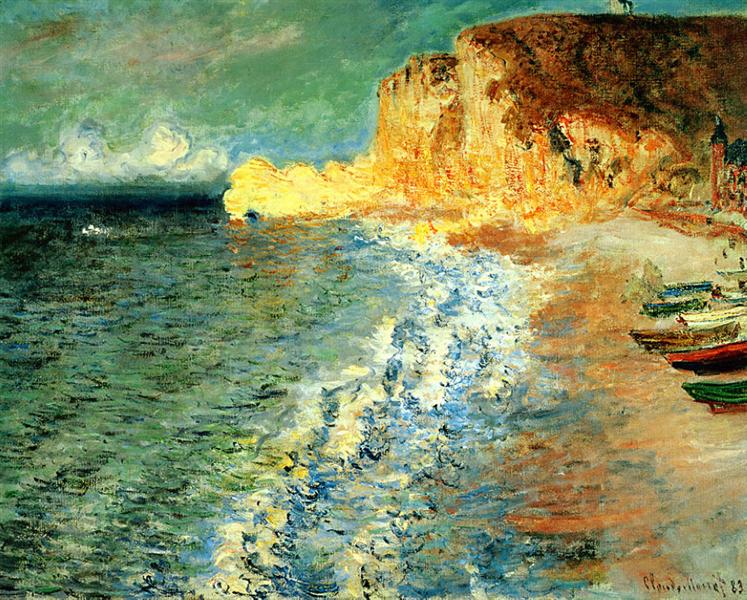Description
Claude Monet's Morning at Étretat, painted in 1883, is a vibrant testament to the Impressionist movement and the artist's mastery of capturing light and atmosphere in his seascapes. One of the founders of Impressionism, Monet achieved in this work a sensorial immersion in the natural beauty of the Normandy coast, a place that fascinated him both for its landscape and its changing luminosity. This painting, like many of its time, was conceived outdoors, allowing Monet to observe in real time the nuances of the sunrise and its effect on the sea and the land.
Visually, "Morning at Étretat" captures a scene in which the calm of the morning is reflected in the gentle ripples of the water, which, bathed in blue and green hues, seem to dance in the light filtering through a thin veil of mist. The composition focuses on Étretat's iconic stone arch, which stands majestically in the background, while the scene unfolds on a plane that maintains visual interest and balance in the landscape layout. Monet employs an almost abstract approach in outlining the arch, omitting minute details and instead using loose brushstrokes that suggest form and texture.
The varied hues Monet uses here, from the deep blues of the ocean to the warm yellows and oranges of the rising sun, demonstrate an exceptional skill in capturing the effect of light on natural elements. The soft touches of color in the sky seem to almost evaporate into thin air, suggesting the passing of time and the fickleness of morning light. This type of color treatment and expression of light and atmosphere are defining characteristics of Impressionism, which Monet masterfully used to evoke emotion and presence in his landscapes.
The presence of human figures in the painting is minimal, which is indicative of Monet's preference to let nature speak for itself. However, a silhouette of a person can be seen on the left who may be contemplating the natural beauty of the place, which adds a human dimension to the work, although it never takes the viewer's attention away from the majestic landscape scene. This also suggests an intimate connection between man and nature, a recurring theme in Monet's work.
"Morning at Étretat" is not only a stunning display of Monet's technique and style, but also a reflection of a time when artists began to break with academic tradition in favor of greater expressive freedom. Monet, through his focus on light and color, transformed the way we perceive landscapes, making this work not only a moment of natural introspection, but also a milestone in the evolution of modern art. The attention to atmospheric detail and use of color in "Morning at Étretat" are in line with his contemporary coastal works such as "The Cliff at Étretat" and "The Beach at Trouville," where he also explores the complex interactions between light, water, and air.
In short, "Morning at Étretat" stands as a work that encapsulates the essence of Impressionism, through which Monet manages to transport the viewer to a specific moment of the day, immortalizing the fleetingness of the morning light and reminding us of the ephemeral beauty of nature. With its masterful technique and focus on visual experience, this painting is not only a delight for the senses, but also a lesson in deep observation of the environment around us.
KUADROS ©, a famous painting on your wall.
Hand-made oil painting reproductions, with the quality of professional artists and the distinctive seal of KUADROS ©.
Painting reproduction service with satisfaction guarantee. If you are not completely satisfied with the replica of your painting, we will refund 100% of your money.

